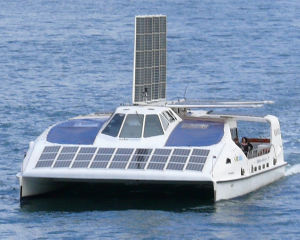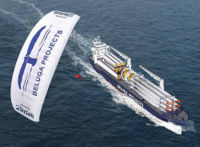Difference between revisions of "Automated transport systems/Automated, zero-emissions ships"
| (One intermediate revision by the same user not shown) | |||
| Line 1: | Line 1: | ||
| − | 90% of international trade is moved by ship<sup>[http://en.wikipedia.org/wiki/Shipping]</sup> | + | 90% of international trade is moved by ship<sup>[http://en.wikipedia.org/wiki/Shipping]</sup>. Imagine if all this cargo could be moved about for free: without no input of human labour or fuel. It would create a true [[Post-scarcity|abundance]] of transport. |
| − | + | An autonomous, clean cargo ship is feasible with currently existing technology. As it would have no fuel or crew costs, even a higher initial construction cost than normal cargo ships would be justified. | |
| − | Ships are | + | Ships are comparatively easy to automate, as there are not many things to bump into out at sea, and they do not have to deal with the high-speed manoeuvering that has challenged designers of autonomous helicopters and cars. There are plenty of small unmanned military boats (USVs for 'unmanned surface vehicles' in military-speak) in operation already, though this technology has not been much applied outside of the military nor on larger boats. With GPS, it is very easy for a ship to be programmed to go from anywhere to anywhere else. Loading and unloading cargo ships has become more and more automated since the 1950s and it is now possible to get containers off ships and into trucks without any human labour. |
| − | There is an abundance of clean energy available at sea. The large surface area of a ship provides ample space for sails and solar panels, and wave power can also be harnessed. | + | There is an abundance of clean [[Fundamental resources/Energy|energy]] available at sea. The large surface area of a ship provides ample space for sails and solar panels, and wave power can also be harnessed. |
[[Image:Solarsailor.jpg|center|thumb|300px|A design integrating sail power and photovoltaic solar cells]] | [[Image:Solarsailor.jpg|center|thumb|300px|A design integrating sail power and photovoltaic solar cells]] | ||
| + | |||
| + | There are several ways to make ships more energy-efficient. One is to design large catamarans, which tend to use less fuel than monohulls of equivalent size. Catamarans tend to rock more than monohulls, though this may not be a problem for many cargo ships. Trimarans, if properly designed, can offer both the efficiency of a catamaran and the stability of a monohull <sup>[http://www.gizmag.com/ship-design-austal-102-trimaran/12433/]</sup>. | ||
Sail-power is making a comeback in commercial shipping. It makes commercial sense to avail of a free source of energy and sails can now be computer-controlled to automatically turn to the angle that best catches the wind. | Sail-power is making a comeback in commercial shipping. It makes commercial sense to avail of a free source of energy and sails can now be computer-controlled to automatically turn to the angle that best catches the wind. | ||
| Line 12: | Line 14: | ||
[[Image:Skysail.jpg|right|200px]]''SkySails'' are a bit like kitesurfing; a kite-like sail floats above the ship on cables and provides extra pull to move the ship forward. Because the sail is at a higher altitude, it is able to catch the faster winds that exist higher in the air. SkySails provide 10-35% of the energy a ship needs<sup>[http://www.skysails.info/index.php?id=472&L=2]</sup> and run completely autonomously, adjusting themselves to the changing winds. | [[Image:Skysail.jpg|right|200px]]''SkySails'' are a bit like kitesurfing; a kite-like sail floats above the ship on cables and provides extra pull to move the ship forward. Because the sail is at a higher altitude, it is able to catch the faster winds that exist higher in the air. SkySails provide 10-35% of the energy a ship needs<sup>[http://www.skysails.info/index.php?id=472&L=2]</sup> and run completely autonomously, adjusting themselves to the changing winds. | ||
| − | |||
Although there are designs for [http://www.wilhelmsen.com/about/CorpSocResp/Environment/Pages/Orcelle-theconcept.aspx large cargo ships with zero emissions] and small autonomous boats with zero emissions<sup>[http://users.soe.ucsc.edu/~elkaim/elkaim/Altantis%20Project.html] [http://users.soe.ucsc.edu/~elkaim/elkaim/Solar%20Autonomous%20Boat.html]</sup>, there are not yet any designs for large, autonomous, zero-emissions cargo ships. Time for an [[Open collaborative design|open-source design]] project, perhaps? | Although there are designs for [http://www.wilhelmsen.com/about/CorpSocResp/Environment/Pages/Orcelle-theconcept.aspx large cargo ships with zero emissions] and small autonomous boats with zero emissions<sup>[http://users.soe.ucsc.edu/~elkaim/elkaim/Altantis%20Project.html] [http://users.soe.ucsc.edu/~elkaim/elkaim/Solar%20Autonomous%20Boat.html]</sup>, there are not yet any designs for large, autonomous, zero-emissions cargo ships. Time for an [[Open collaborative design|open-source design]] project, perhaps? | ||
Latest revision as of 02:24, 8 July 2010
90% of international trade is moved by ship[1]. Imagine if all this cargo could be moved about for free: without no input of human labour or fuel. It would create a true abundance of transport.
An autonomous, clean cargo ship is feasible with currently existing technology. As it would have no fuel or crew costs, even a higher initial construction cost than normal cargo ships would be justified.
Ships are comparatively easy to automate, as there are not many things to bump into out at sea, and they do not have to deal with the high-speed manoeuvering that has challenged designers of autonomous helicopters and cars. There are plenty of small unmanned military boats (USVs for 'unmanned surface vehicles' in military-speak) in operation already, though this technology has not been much applied outside of the military nor on larger boats. With GPS, it is very easy for a ship to be programmed to go from anywhere to anywhere else. Loading and unloading cargo ships has become more and more automated since the 1950s and it is now possible to get containers off ships and into trucks without any human labour.
There is an abundance of clean energy available at sea. The large surface area of a ship provides ample space for sails and solar panels, and wave power can also be harnessed.
There are several ways to make ships more energy-efficient. One is to design large catamarans, which tend to use less fuel than monohulls of equivalent size. Catamarans tend to rock more than monohulls, though this may not be a problem for many cargo ships. Trimarans, if properly designed, can offer both the efficiency of a catamaran and the stability of a monohull [2].
Sail-power is making a comeback in commercial shipping. It makes commercial sense to avail of a free source of energy and sails can now be computer-controlled to automatically turn to the angle that best catches the wind.
SkySails are a bit like kitesurfing; a kite-like sail floats above the ship on cables and provides extra pull to move the ship forward. Because the sail is at a higher altitude, it is able to catch the faster winds that exist higher in the air. SkySails provide 10-35% of the energy a ship needs[3] and run completely autonomously, adjusting themselves to the changing winds.Although there are designs for large cargo ships with zero emissions and small autonomous boats with zero emissions[4] [5], there are not yet any designs for large, autonomous, zero-emissions cargo ships. Time for an open-source design project, perhaps?

